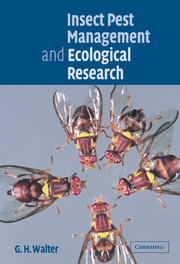Book contents
- Frontmatter
- Contents
- Preface
- Acknowledgements
- 1 Introduction
- Part 1 The place and nature of insect ecology research for IPM
- Part 2 Specific directions in insect ecology research for IPM
- 6 Understanding species: good taxonomy, sexual species and pest management
- 7 Polyphagous pests, parasitoids and predators: trophic relations, ecology and management implications
- 8 Pre-release evaluation and selection of natural enemies: population and community criteria
- 9 Autecological research on pests and natural enemies
- Part 3 Synopsis: Ecological research for IPM today
- References
- Index
6 - Understanding species: good taxonomy, sexual species and pest management
Published online by Cambridge University Press: 22 August 2009
- Frontmatter
- Contents
- Preface
- Acknowledgements
- 1 Introduction
- Part 1 The place and nature of insect ecology research for IPM
- Part 2 Specific directions in insect ecology research for IPM
- 6 Understanding species: good taxonomy, sexual species and pest management
- 7 Polyphagous pests, parasitoids and predators: trophic relations, ecology and management implications
- 8 Pre-release evaluation and selection of natural enemies: population and community criteria
- 9 Autecological research on pests and natural enemies
- Part 3 Synopsis: Ecological research for IPM today
- References
- Index
Summary
It was a startling revelation that seven species with very distinct biologies had been confused under the taxon Anopheles maculipennis. The study of the An. maculipennis complex, more than any other, served to demonstrate the critical importance of cryptic (or sibling) species in ecology. ‘Species sanitation’ took on a new significance and a new complexity. The mysterious ‘Anophelism without malaria’, which had been such a feature of malaria in western Europe, was at last elucidated. It slowly became clear that the identification of … species on morphological grounds is often not good enough. …
h. e. paterson (1993a, p. 39)And Einstein's theory, developed on what appeared to many of his contemporaries as a very frugal basis on which to found a physical theory, has revealed a richness of content that continues to baffle the imagination.
s. chandrasekhar (1990, p. 286)Introduction
One of the most basic aspects in tackling any pest management problem is the initial identification of the species involved, whether it be pest or beneficial. A great number of expensive mistakes have followed identification failure. Fortunately, some of these have been well documented (Annecke & Moran, 1977; Clarke, 1990; Compere, 1961; Delucchi et al., 1976), and a common call in the applied entomology literature is for ‘good taxonomy’ to underlie pest management. One of the main points made in this chapter is that good taxonomy on its own is frequently insufficient to solve the problem at hand.
- Type
- Chapter
- Information
- Insect Pest Management and Ecological Research , pp. 115 - 168Publisher: Cambridge University PressPrint publication year: 2003
- 2
- Cited by



